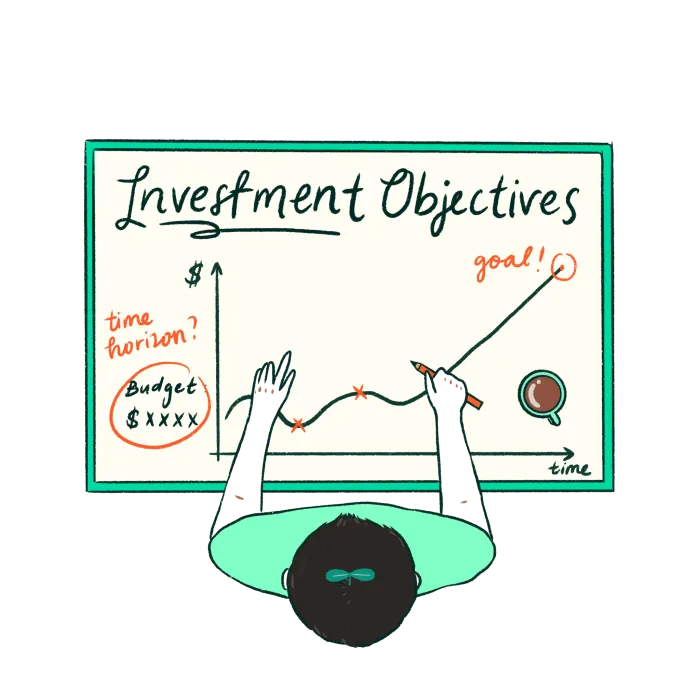What you need to know before you start investing In Singapore! Beansprout's checklist before you get started
By Beansprout • 01 Aug 2022 • 0 min read
Have you ever wondered how to start investing in Singapore? Here is our definitive step-by-step guide to get you started and make profits.

In this article
What you'll learn
- Set aside an emergency fund
- Outline your investment objectives
- Know your willingness and ability to take risks
TL;DR
- Keep an emergency fund in a high-interest savings account that is easily accessible.
- Before you deposit your money into a brokerage account, you need to answer the question: What do I hope to achieve from investing?
- You should allocate your investments based on your ability to handle risk.
Step 1: Set aside an emergency fund

Prior to thinking about how to invest in Singapore, it is important to set aside an emergency fund.
An emergency fund is a reserve of money that covers expenses you wouldn’t normally plan for. This may include any unexpected financial surprises in life such as medical emergencies, job loss, or unexpected travel.
This emergency fund will be kept as money in a high-interest savings account that is easily accessible. After all, cash is the most liquid asset class.
Liquidity here refers to how easily an asset is converted to cash without any loss of purchasing power.
Imagine the money in your bank account as water, the money you stored in a government savings bond as cooking oil, and the money you have in the property as creamy peanut butter. If you need to pour these liquids out, water will be emptied the fastest because it’s the most liquid.
As a general rule of thumb, it is recommended to set aside six months’ worth of your expenses.
Only after you’ve set aside your personal emergency fund then should you start looking at investing in various assets.
Step 2: Outline your investment objectives

Before you deposit your money into a brokerage account, you need to answer the question: What do I hope to achieve from investing?
If you are saving up for a big-ticket item (downpayment for a HDB flat, car, etc) what is your target goal? This requires you to understand a bit more about yourself in relation to the goals you have in life.
Investing is about understanding yourself and your goals as much as it is understanding financial markets.
Setting targets for your investment goals will naturally require an assessment of your overall financial situation, factoring in the size of your emergency fund, financial support for your dependents (if any), and other financial considerations.
You can think of this as customising the side and rear mirrors in your car before driving it for the first time–it’s very much personalised.
Everyone has different priorities and goals they set for themselves, so you should take sometime to think about what this means to you.
Once you’ve established the basis for your investments, you can begin to dive into deeper questions about your investing journey.
For example, should you opt for passive or active investing? The former may involve investing in exchange-traded funds (ETFs), which are broad-based index funds that track a basket of stocks. The latter approach might be taken by some investors who want to actively manage their own money.
But what if I don’t know how to invest in Singapore stocks? Or what if I’m unsure of whether to invest in the US stock market or the Singapore stock market?
If you can’t decide, you can instead open an investment account with a Robo-advisor: an automated investment management service that relies on computerised algorithms to build your investment portfolio.
Overall, asking questions like these will allow you to understand your investment options available and to pick an investment strategy best suited for your needs.
Step 3: Know your willingness and ability to take risks

Most people do not realise this, but investing is very much about managing risks.
Firstly, you should identify your personal willingness to take risks. This refers to the degree of risk you are comfortable with taking. Market volatility in the short-term period is to be expected, but some investors may be able to stomach market fluctuations while others might find themselves losing sleep at night.
It ultimately comes down to the threshold of risk that an investor is willing to take, which varies from person to person.
This will depend on a variety of factors such as your personality type, self-confidence, financial knowledge, investor experience, and mentality. Unfortunately, the question of how to start investing in Singapore is not so simple!
Secondly, you should allocate your investments based on your ability to handle risk.
You don’t want to be caught in a situation where you’ve over-invested, exposing yourself to more risk than you can handle.
Generally speaking, the more money you have, the more risk you can afford. Losing $1,000 is different for a person who has $10,000 in their portfolio as compared to someone who has a six-figure sum portfolio.
Another consideration is your age–if you’re in your mid-20s earning a stable income, you’re unlikely to need to use your retirement savings for the next three decades or so.
Since you have a relatively long time horizon, it arguably allows you to allocate more money to stocks. But if you’re approaching your retirement age, you might want to reduce your exposure to stocks and instead opt for a more conservative strategy that carries less risk.
Take the next step
The key to beginning your investing journey is to make the first step and actually get started.
For most people, investing can seem like a really daunting process until you actually do it for the first time. It also doesn’t matter if you have a small amount of money, the trick is to get started today.
Here are a few additional resources to get you started:
- It may also be helpful to find an online brokerage platform with a beginner-friendly user interface. Find out how to set up a brokerage account here.
- If you’re afraid of picking individual stocks, you can explore index funds that give you broad market exposure. In fact, purchasing units in an index fund is a common way for new investors to take their first step into the stock market. Read more about what are exchange traded funds

Illustrations by @charlycatfightsback
This article was first published on 01 August 2022 .
Gain financial insights in minutes
Subscribe to our free weekly newsletter for more insights to grow your wealth